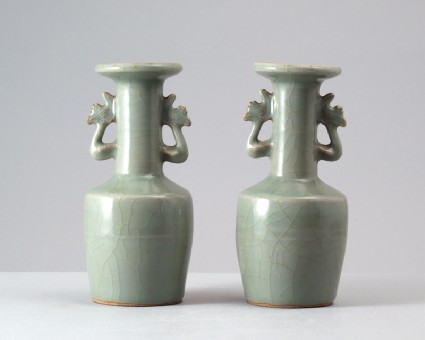Browse: 1240 objects
Greenware kinuta, or mallet, vase with phoenix handles
- loan
-
Details
- Associated place
-
Asia › China › Zhejiang province › Longquan kilns (place of creation)
- Date
-
13th century (1201 - 1300)
Southern Song Dynasty (1127 - 1279)
- Material and technique
- stoneware, thrown, with incised and moulded decoration under a green crackled glaze; handles luted to the vase with slip; glazed base; glazed rim
- Dimensions
-
16.8 cm (height)
7.8 cm (diameter)
at base 6.1 cm (diameter)
- Material index
- Technique index
- Object type index
- No. of items
- 1
- Credit line
- Lent by the Sir Alan Barlow Collection Trust.
- Accession no.
- LI1301.102.1
-
Further reading
University of Sussex, and Arts and Humanities Research Council, The Barlow Collection, supervised by Regina Krahl, Maurice Howard, and Aiden Leeves (Sussex: University of Sussex, 2006), no. C74
Glossary (5)
glaze, luted, phoenix, slip, stoneware
-
glaze
Vitreous coating applied to the surface of a ceramic to make it impermeable or for decorative effect.
-
luted
The fusion of parts of ceramics using dilute clay slip.
-
phoenix
Mythical bird known as hōō in Japan. The Islamic tradition appropriated the far-eastern iconography of the phoenix and used it to represent another mythical bird, the simurgh.
-
slip
A semi-fluid clay applied to a ceramic before glazing either to coat the surface or for decorative effect.
-
stoneware
Ceramic material made of clay which is fired to a temperature of c.1200-1300⁰c and is often buff or grey in colour.
Location
-
- currently in research collection
Objects are sometimes moved to a different location. Our object location data is usually updated on a monthly basis. Contact the Jameel Study Centre if you are planning to visit the museum to see a particular object on display, or would like to arrange an appointment to see an object in our reserve collections.
Publications online
-

The Barlow Collection
This shape is known by the Japanese term kinuta (‘mallet’), since pieces of this shape, with a fine even blue-green glaze, were particularly popular in Japan. The best Longquan glazes have, by extension, become known as kinuta glazes.
The small vases have straight sides, a slanting angled shoulder, a tall cylindrical neck with a wide everted rim with raised lip, and two handles shaped in form of stylized phoenixes. The phoenix heads are shown in profile with crests and details raised in moulded relief, their long necks angled, the rudimentary bodies flanked by raised ribs to indicate wings. The even yellowish-green glaze shows a wide-meshed crackle. It covers the bases, but leaves the broad shallow footrings free, the biscuit having fired a yellowish-brown colour.
© 2013 University of Oxford - Ashmolean Museum




